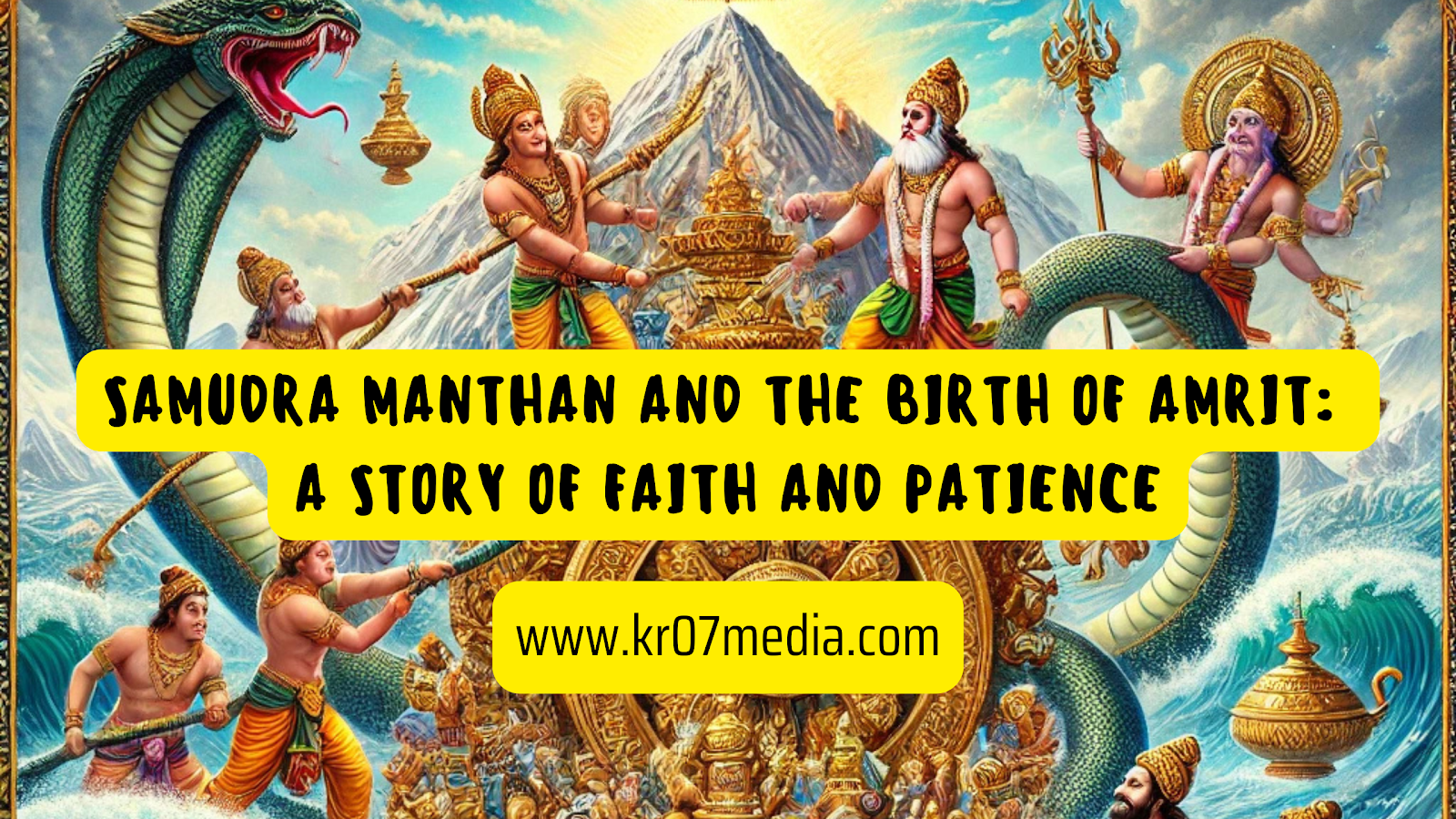The tale of Samudra Manthan, or the Churning of the Ocean, is one of the most profound legends in Hindu mythology. It’s a story of gods and demons, a quest for eternal nectar, and the remarkable patience and faith that brought forth divine treasures and the potent nectar, Amrit, that granted immortality. This story, recorded in the Bhagavata Purana and other ancient texts, serves as a timeless reminder of the rewards of perseverance, teamwork, and the power of faith.
The Roots of Samudra Manthan
The Samudra Manthan begins with a cosmic crisis. Indra, the king of the gods, loses his divine power due to a curse by the sage Durvasa. The curse creates imbalance and vulnerability in the celestial world, allowing the Asuras (demons) to gain an advantage. Realizing the need to regain their strength, the gods seek advice from Lord Vishnu, the preserver of the universe. He advises them to churn the Ksheera Sagar, or the Ocean of Milk, to obtain Amrit, the nectar of immortality, which would restore their power.
However, the task is not simple. Churning the vast ocean required both enormous physical strength and magical cooperation between the opposing forces of the gods (Devas) and the demons (Asuras). While the two sides were enemies, they reached an unusual agreement to work together to extract the nectar, with the understanding that they would share the rewards.
The Process of Churning the Ocean
The churning itself was no ordinary task. They used the sacred Mount Mandara as the churning rod and the great serpent Vasuki as the churning rope. Lord Vishnu, understanding the risks involved, took the form of a giant tortoise, Kurma, to support the mountain on his back as it spun, preventing it from sinking into the depths of the ocean.
The gods and demons pulled Vasuki on opposite sides, churning the ocean with intense force. However, before the nectar of immortality could emerge, the churning brought forth a series of divine and dangerous objects, each with symbolic significance.
The Treasures and Poisons of the Ocean
The first to emerge was a potent poison, Halahala, threatening to destroy all creation. This was a test of patience and faith for both sides. Recognizing the danger, Lord Shiva stepped forward and drank the poison to save the universe. His consort, Goddess Parvati, held his throat, preventing the poison from descending, thus turning his throat blue, earning him the name Neelkanth (the blue-throated one). This act of sacrifice is revered as a symbol of divine protection and selflessness.
Following the poison came several celestial treasures, each with unique powers:
The Kaustubha gem, which adorned Lord Vishnu’s chest.
The Kalpavriksha, or wish-fulfilling tree.
The Kamadhenu, the divine cow that could grant any wish.
The Airavata, the multi-tusked white elephant that became the vehicle of Indra.
The Apsaras, celestial maidens who would reside in Indra’s court.
The arrival of each treasure symbolized the material and spiritual rewards of patience, reminding the Devas and Asuras of their ultimate goal, the Amrit. Finally, after intense perseverance, the Dhanvantari, the divine physician, appeared from the depths, holding a pot of the coveted nectar.
The Birth of Amrit and Its Protection
The appearance of Amrit led to a conflict, as the Asuras tried to seize it for themselves. Realizing the danger, Lord Vishnu took the form of the enchantress Mohini, who bewitched the Asuras with her beauty and persuaded them to allow her to distribute the nectar. In her divine wisdom, she ensured that the gods received the nectar, restoring their strength and granting them the power to protect the cosmos.
However, one Asura named Rahu disguised himself as a god and drank the nectar. The sun and moon revealed Rahu’s deception to Mohini, and Lord Vishnu beheaded Rahu. Yet, having consumed a few drops, Rahu attained immortality, his head becoming the shadow planet Rahu, and his body, Ketu. This tale also explains the Hindu mythology of solar and lunar eclipses, as it’s believed that Rahu chases the sun and moon in revenge, causing them to disappear temporarily from the sky.
The Lessons of Faith and Patience
The story of Samudra Manthan is more than just a tale of gods and demons. It embodies profound life lessons about patience, teamwork, and faith. It demonstrates that great goals require effort, cooperation, and sacrifice. The gods and demons—mortal enemies—had to set aside their differences to achieve a greater purpose. The obstacles they faced, including the emergence of poison, taught them to remain patient and steadfast, even when the situation seemed overwhelming.
The journey of churning the ocean, encountering dangerous poison, and finally receiving divine treasures emphasizes that life’s rewards are often preceded by trials. This tale is an allegory for the soul's journey, where patience, discipline, and faith lead to spiritual enlightenment and liberation.
Conclusion
The legend of Samudra Manthan and the birth of Amrit continues to inspire followers of Hinduism and serves as a reminder of the values of resilience, unity, and belief in divine grace. It’s a timeless message that even in the face of adversity, one’s faith and patience can lead to rewards far greater than imagined.



